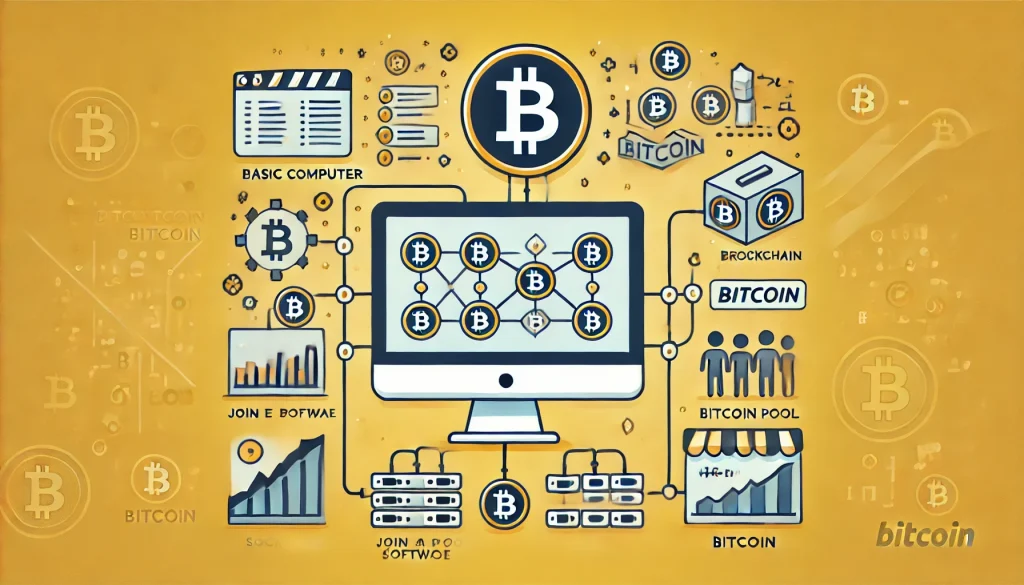How to Mine Bitcoin: A Complete Beginner’s Guide to Getting Started

Introduction
How to Mine Bitcoin: Bitcoin mining is the process of validating transactions on the Bitcoin blockchain by solving complex cryptographic puzzles, a task that requires substantial computing power. Successful miners are rewarded with new bitcoins, making mining a potentially profitable venture. If you’re new to the world of Bitcoin mining, this comprehensive guide will help you understand what Bitcoin mining is, how to get started, the hardware and software requirements, and the steps to optimize your mining operation.
Table of Contents
What is Bitcoin Mining?
Bitcoin mining serves two primary purposes:
- Transaction Validation: Every transaction made on the Bitcoin network must be validated and added to the blockchain, a public ledger.
- New Bitcoin Creation: The process introduces new bitcoins into circulation, making it the only way to create new bitcoins.
Bitcoin mining involves miners solving complex mathematical problems called “hashes.” The first miner to solve the hash for a new block of transactions earns a reward in Bitcoin (currently 6.25 BTC per block, as of 2024) and adds the block to the blockchain.
How Does Bitcoin Mining Work?
Bitcoin uses a Proof of Work (PoW) consensus algorithm, which requires miners to compete against one another to solve a cryptographic puzzle. The miner who first solves the puzzle can add the new block to the blockchain. This process relies on a hashing function known as SHA-256, which outputs a fixed 256-bit number. The goal is to find a hash lower than the target value set by the Bitcoin network, which adjusts based on mining difficulty.
Key Terms to Understand:
- Hash Rate: The number of hash operations a mining device can perform per second.
- Difficulty: A measure of how hard it is to find a new block. The Bitcoin network adjusts the difficulty every 2,016 blocks (approximately every two weeks) to ensure that blocks are found roughly every 10 minutes.
- Block Reward: The number of bitcoins awarded to the miner who successfully adds a new block to the blockchain. The reward halves every 210,000 blocks (roughly every four years) in an event known as the Bitcoin halving.
Now that you have a basic understanding of how Bitcoin mining works, let’s explore the step-by-step process of setting up your own mining operation.
Step 1: Understand the Costs of Bitcoin Mining
Before diving into Bitcoin mining, it’s essential to understand the various costs associated with it. Mining is resource-intensive and requires a significant investment in hardware, electricity, and cooling.
Hardware Costs
The most critical component of Bitcoin mining is the hardware. Initially, it was possible to mine Bitcoin using a regular computer or a high-end gaming PC, but the increasing difficulty has made this impractical. Today, miners use specialized equipment known as Application-Specific Integrated Circuits (ASICs), which are purpose-built for mining Bitcoin.
- ASICs: These machines are optimized for mining and offer the best performance but come at a significant upfront cost, ranging from $1,500 to $10,000 or more, depending on the model and hash rate.
- GPUs: Graphics Processing Units (GPUs) were once popular for mining, but they are no longer competitive in Bitcoin mining. However, they are still used for mining other cryptocurrencies like Ethereum.
- CPUs: Central Processing Units (CPUs) are the least effective option for mining and are not suitable for Bitcoin mining today.
Electricity Costs
Mining consumes a significant amount of electricity due to the high power requirements of ASICs. The cost of electricity will vary depending on your location, but it’s important to calculate these expenses upfront to determine whether mining is profitable for you. High electricity rates can drastically reduce your profits.
- Power Consumption: ASICs can consume anywhere from 1,000 to 3,500 watts of power or more.
- Cooling Requirements: Mining machines generate a lot of heat, so you’ll need adequate cooling systems to prevent overheating, adding to your electricity costs.
Internet Connection
Mining also requires a reliable internet connection, as your mining rig will need to stay online and in sync with the Bitcoin network. While mining doesn’t require a super-fast connection, it does need to be stable to prevent any interruptions.
Step 2: Choose Your Bitcoin Mining Hardware
As mentioned earlier, ASIC miners are the most efficient option for mining Bitcoin today. Some popular models include:
- Antminer S19 Pro: With a hash rate of 110 TH/s (terahashes per second) and a power consumption of 3250W, the Antminer S19 Pro is one of the most powerful and energy-efficient Bitcoin miners on the market.
- WhatsMiner M30S++: Offering a hash rate of 112 TH/s with a power consumption of 3472W, this is another top-tier option for serious miners.
- AvalonMiner 1246: This model has a hash rate of 90 TH/s and consumes 3420W of power, making it a competitive choice.
When selecting a miner, it’s crucial to consider its hash rate (performance) and power consumption. The efficiency of a miner can be measured using its Joules per Terahash (J/TH) rating, which indicates how much energy is used to generate one terahash of mining power.
Step 3: Select a Bitcoin Mining Pool
Mining Bitcoin solo is extremely difficult because of the high level of competition and the increasing difficulty of solving blocks. Most miners join mining pools, where they combine their hashing power with others to increase their chances of earning rewards. When the pool successfully mines a block, the reward is distributed among participants based on the amount of computational power they contributed.
Some popular Bitcoin mining pools include:
- Slush Pool: One of the oldest and most reputable mining pools, offering a transparent reward system and low fees.
- F2Pool: A large multi-currency mining pool with a strong reputation and regular payouts.
- Antpool: Operated by Bitmain, the same company that manufactures the Antminer ASICs, Antpool is one of the largest Bitcoin mining pools.
When choosing a mining pool, consider the pool’s fees, payout structure, and reliability.
Types of Payout Structures
- Pay-Per-Share (PPS): Miners are paid a fixed amount for each share they submit, regardless of whether the pool finds a block.
- Proportional: Miners are paid based on the proportion of work they contribute to finding a block.
- Pay-Per-Last-N-Shares (PPLNS): Similar to proportional, but rewards are distributed based on the number of shares miners contributed to the last N shares, rather than a fixed amount of time.
Step 4: Set Up Your Bitcoin Mining Software
After setting up your hardware and choosing a mining pool, you’ll need mining software to control your miner and connect to the pool. Some popular Bitcoin mining software options include:
- CGMiner: One of the oldest and most feature-rich mining programs, supporting a wide range of hardware, including ASICs and GPUs.
- BFGMiner: A more advanced mining software that allows users to mine multiple cryptocurrencies simultaneously.
- NiceHash: A user-friendly platform that allows miners to rent out their hash power to others in exchange for Bitcoin.
Once you’ve chosen your software, follow these steps to get started:
- Download and Install the Software: Install the software on the device connected to your mining rig.
- Configure the Software: You’ll need to enter your mining pool’s URL and your worker credentials (usually provided by the pool) into the software.
- Start Mining: After configuration, start the mining process. The software will begin solving hashes and submitting work to the mining pool.
Step 5: Calculate Your Mining Profitability
Before you commit to mining, it’s important to calculate whether it will be profitable based on your hardware, electricity costs, and expected hash rate.
Mining Profitability Calculators
Several online calculators can help you estimate your mining profitability:
- WhatToMine: A popular tool that allows you to input your hardware, hash rate, power consumption, and electricity costs to calculate potential earnings.
- CryptoCompare: Another great tool for estimating profitability, including options to compare different mining setups.
When calculating profitability, consider the following factors:
- Bitcoin Price: The price of Bitcoin fluctuates, and your profitability will be closely tied to its market value.
- Mining Difficulty: As more miners join the network, the difficulty increases, making it harder to mine new blocks.
- Electricity Costs: High electricity costs can significantly reduce your profits, so ensure your rates are competitive.
Step 6: Manage and Monitor Your Mining Operation
Once your mining operation is up and running, you’ll need to monitor it to ensure optimal performance and address any issues that arise.
Mining Monitoring Tools
- MinerStat: A comprehensive monitoring platform that provides real-time data on your miner’s performance, temperatures, and hash rates.
- Awesome Miner: A mining management software that supports multiple hardware devices and allows you to monitor them from a single dashboard.
- Hive OS: A popular choice among miners for managing large mining farms, with support for ASICs and GPUs.
Maintenance Tips
- Regular Cleaning: Dust and debris can clog fans and cause your miner to overheat. Regular cleaning will help ensure it runs efficiently.
- Cooling: Make sure your mining rig is adequately cooled to prevent overheating, which can cause downtime or damage to your hardware.
- Firmware Updates: Keep your ASIC firmware up to date to ensure you’re using the most efficient settings for your miner.
Step 7: Popular Bitcoin Mining Hardware Providers
If you’re serious about Bitcoin mining, you’ll need to invest in high-quality hardware. Below are some of the leading manufacturers of ASIC miners:
- Antminer (Bitmain)
- Website: bitmain.com
- Location: Headquartered in Beijing, China.
- About: Bitmain is one of the largest and most reputable manufacturers of ASIC mining hardware, known for their Antminer series, including the Antminer S19 Pro.
- WhatsMiner (MicroBT)
- Website: microbt.com
- Location: Shenzhen, China.
- About: MicroBT produces the WhatsMiner series of Bitcoin miners, which are highly competitive in terms of performance and efficiency.
- Canaan (AvalonMiner)
- Website: canaan.io
- Location: Hangzhou, China.
- About: Canaan is a leading provider of blockchain servers and solutions, and their AvalonMiner line is widely used in Bitcoin mining.
- Innosilicon
- Website: innosilicon.com
- Location: China, with offices in the U.S. and Hong Kong.
- About: Innosilicon is known for its innovative chip design and high-performance miners, including the T3+ Pro series.
Step 8: Top Bitcoin Mining Pools
Mining pools combine the computational power of multiple miners, increasing the chances of solving a block. Here are some well-known and reputable Bitcoin mining pools:
- Slush Pool
- Website: slushpool.com
- Location: Based in the Czech Republic, but open to miners globally.
- About: Slush Pool is the world’s oldest mining pool, founded in 2010. It offers a transparent payout system and is a popular choice among miners.
- F2Pool
- Website: f2pool.com
- Location: Headquartered in Beijing, China, but operates worldwide.
- About: F2Pool is a multi-currency mining pool that supports Bitcoin, Ethereum, and other cryptocurrencies. It has a large network of miners and regular payouts.
- Antpool
- Website: antpool.com
- Location: Operated by Bitmain and based in China.
- About: As one of the largest mining pools, Antpool provides miners with reliable and low-fee options for contributing their hashing power.
- BTC.com
- Website: btc.com
- Location: Global presence, founded by Bitmain in China.
- About: BTC.com is one of the most popular Bitcoin mining pools and offers a highly reliable platform with competitive fees and a user-friendly interface.
Step 9: Bitcoin Mining Software Providers
Once you’ve selected your hardware and mining pool, you’ll need software to get your mining operation running. Below are a few widely used software providers:
- CGMiner
- Website: cgminer.info
- About: One of the most popular open-source mining programs, CGMiner supports ASIC mining and offers extensive features for advanced miners.
- BFGMiner
- Website: bfgminer.org
- About: BFGMiner is a modular ASIC and FPGA mining software that allows users to mine multiple cryptocurrencies and customize their mining operations.
- NiceHash
- Website: nicehash.com
- Location: Slovenia.
- About: NiceHash offers a user-friendly marketplace where you can buy or sell hashing power. It also provides a mining software that is easy to set up for beginners.
These websites and companies offer essential resources for getting started in Bitcoin mining. Whether you’re selecting hardware, joining a mining pool, or configuring mining software, it’s important to research these providers to ensure you’re making the best decisions for your setup.
Conclusion
Bitcoin mining can be a profitable venture, but it requires significant investment in hardware, electricity
, and time. By following this beginner’s guide, you’ll have a solid understanding of the necessary steps to set up and optimize your mining operation. From selecting the right hardware to choosing a mining pool and monitoring your performance, the key to successful Bitcoin mining lies in careful planning and continuous optimization.
If you’re ready to start mining, take the time to research and calculate the potential costs and profits before making your investment. Mining may not be for everyone, but for those with the right resources and dedication, it can be a rewarding way to participate in the Bitcoin network and potentially earn some Bitcoin in the process.


